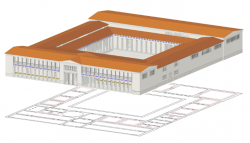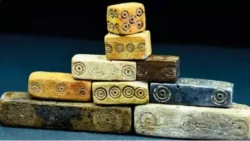INSTITUT SUPERIEUR D'ANTHROPOLOGIE
INSTITUTE OF ANTHROPOLOGY
ONLINE COURSES / COURS A DISTANCE
SUMMER TERM : JULY 2018
REGISTER NOW
DANEMARK –  Ribe - Excavations carried out in the vicinity of Ribe Cathedral from 2008-2012 uncovered a graveyard containing around 3,000 bodies – and they were Christians. The graveyard dates from the years 860-1050 and the numbers equate to around 10-15 burials per year during the time Ansgar was a missionary in Denmark, reports Politiken. Danes were Christians around 100 years before Harald Bluetooth was baptised in 966 and immortalised on the Jelling Stones as the man who made Denmark Christian. “There is little doubt that this is Ansgar’s Church(yard) and Ribe Cathedral is able to trace its roots back to the middle of the 9th century,” stated Morten Søvsø from the archaeological department at the Museum of Southwest Jutland. When the Danish king Harald Klak was baptised in 826 in Ingenheim on the Rhine, a young monk named Ansgar was sent to Denmark as a follow-up. So even though Harald has taken the credit for converting the Danes, according to Bramming it was a long, unbroken process dating back to Ansgar’s pioneering missionary work, which continued with the extensive church building program in 1000-1200 when Christianity really took hold in Denmark.
Ribe - Excavations carried out in the vicinity of Ribe Cathedral from 2008-2012 uncovered a graveyard containing around 3,000 bodies – and they were Christians. The graveyard dates from the years 860-1050 and the numbers equate to around 10-15 burials per year during the time Ansgar was a missionary in Denmark, reports Politiken. Danes were Christians around 100 years before Harald Bluetooth was baptised in 966 and immortalised on the Jelling Stones as the man who made Denmark Christian. “There is little doubt that this is Ansgar’s Church(yard) and Ribe Cathedral is able to trace its roots back to the middle of the 9th century,” stated Morten Søvsø from the archaeological department at the Museum of Southwest Jutland. When the Danish king Harald Klak was baptised in 826 in Ingenheim on the Rhine, a young monk named Ansgar was sent to Denmark as a follow-up. So even though Harald has taken the credit for converting the Danes, according to Bramming it was a long, unbroken process dating back to Ansgar’s pioneering missionary work, which continued with the extensive church building program in 1000-1200 when Christianity really took hold in Denmark.
http://cphpost.dk/news/danes-were-christians-long-before-harald-bluetooth-took-the-credit.html
ROYAUME UNI - Stamford Bridge - The 1066 battle of Stamford Bridge between Viking warlord Harald Hardrada and King Harold of England was said to be so violent that a giant mountain of bones remained a half century later. (1:51)
VIDEO = https://www.smithsonianmag.com/videos/category/history/the-violent-1066-battle-of-stamford-bridge/#PxDVSeXTKQLxHIfy.99
SUEDE –  Norrköping - Archeologists have discovered a 250-year-old box of Swedish snus, still half-filled with the noxious oral tobacco mix. “It smelled of tobacco. It was basically just snus,” Karin Lindeblad, from the consulting firm Arkeologerna, told The Local. The box was found during the excavation of the old inner harbour in the Swedish city of Norrköping, 160km south of Stockholm. “We found it under one-and-a half metres of clay, where there was no oxygen," Lindeblad said. "So the brass snus box was still golden, it was still shimmering. It was really well-preserved.” The product is made by blending powdered tobacco powder with salt, water and spices, and has been made in Norrköping since at least 1760, about ten years before the archeologists believe the box was dropped into the estuarial mud. Lindblad believes the initials PGW refer to Pehr Gustaf Wadström, a businessman and industrialist, who owned one of the wharves in Norrköping.
Norrköping - Archeologists have discovered a 250-year-old box of Swedish snus, still half-filled with the noxious oral tobacco mix. “It smelled of tobacco. It was basically just snus,” Karin Lindeblad, from the consulting firm Arkeologerna, told The Local. The box was found during the excavation of the old inner harbour in the Swedish city of Norrköping, 160km south of Stockholm. “We found it under one-and-a half metres of clay, where there was no oxygen," Lindeblad said. "So the brass snus box was still golden, it was still shimmering. It was really well-preserved.” The product is made by blending powdered tobacco powder with salt, water and spices, and has been made in Norrköping since at least 1760, about ten years before the archeologists believe the box was dropped into the estuarial mud. Lindblad believes the initials PGW refer to Pehr Gustaf Wadström, a businessman and industrialist, who owned one of the wharves in Norrköping.
https://www.thelocal.se/20180606/archeologists-find-300-year-old-tin-of-swedis-snus-tobacco
GRECE – 
 Aigai - The archaeological site of the palace of Aigai, considered not only the biggest but, together with the Parthenon, the most significant building of classical Greece, opened to visitors this week. Constructed during the reign of Philip II (359-336 BC) on a raised outcrop in modern day Vergina, northern Greece, the palace — three times the size of Parthenon — was visible from the whole Macedonian basin; a remarkable landmark, a symbol of power and beauty.The palace of Aigai was designed for Philip by an ingenious architect — probably Pytheos, known for his contribution to the construction of the Mausoleum at Halicarnassus and to the development of urban planning and the theory of proportion. The masonry and architectural members, all artfully processed, were covered with lustrous high-quality marble stucco that resembles marble and calls to remembrance Vitruvius’ description of the plaster used in Mausolus’ palace that shined as if made of glass. Thousands of roofing tiles and relief antefixes of excellent quality, hundreds of square meters of floors covered with marble inlays and mosaics, some of which constitute exceptional works of art, extravagant pigments, bronze and all kinds of luxurious materials were used to create a complex that would fulfill the king’s ambition. However, beyond the luxurious materials, the inventiveness and perfection of construction techniques, and the astonishing technological achievements traced on all levels of construction, the most fascinating and dominant element of this unique building is its ingenious architectural conception. The large square peristyle (row of columns surrounding a space within a building) — the ‘heart’ of the building — together with the areas surrounding it, and the impressive propylon (structure forming the entrance to a building) enclosed by stoes (porticos, roofed colonnades) that form the facade, constitute the basic elements of this innovative-for-its-era architectural project.
Aigai - The archaeological site of the palace of Aigai, considered not only the biggest but, together with the Parthenon, the most significant building of classical Greece, opened to visitors this week. Constructed during the reign of Philip II (359-336 BC) on a raised outcrop in modern day Vergina, northern Greece, the palace — three times the size of Parthenon — was visible from the whole Macedonian basin; a remarkable landmark, a symbol of power and beauty.The palace of Aigai was designed for Philip by an ingenious architect — probably Pytheos, known for his contribution to the construction of the Mausoleum at Halicarnassus and to the development of urban planning and the theory of proportion. The masonry and architectural members, all artfully processed, were covered with lustrous high-quality marble stucco that resembles marble and calls to remembrance Vitruvius’ description of the plaster used in Mausolus’ palace that shined as if made of glass. Thousands of roofing tiles and relief antefixes of excellent quality, hundreds of square meters of floors covered with marble inlays and mosaics, some of which constitute exceptional works of art, extravagant pigments, bronze and all kinds of luxurious materials were used to create a complex that would fulfill the king’s ambition. However, beyond the luxurious materials, the inventiveness and perfection of construction techniques, and the astonishing technological achievements traced on all levels of construction, the most fascinating and dominant element of this unique building is its ingenious architectural conception. The large square peristyle (row of columns surrounding a space within a building) — the ‘heart’ of the building — together with the areas surrounding it, and the impressive propylon (structure forming the entrance to a building) enclosed by stoes (porticos, roofed colonnades) that form the facade, constitute the basic elements of this innovative-for-its-era architectural project.
http://greece.greekreporter.com/2018/06/06/palace-of-aigai-biggest-building-of-ancient-greece-opens-to-public-photos/
ISRAEL –  Kilodia - Students from schools in the Lev Hasharon Regional Council helping on an archaeological dig on the Sharon plain have unearthed an ancient coin dating back to the year 300 C.E., among other finds. Most of the finds at the Kilodia site near Moshav Kfar Yavetz, east of Netanya, date to the early Muslim period (700-1050 C.E.). They include glazed bowls, wine jugs, decorative bronze weights, a bronze bell, and semiprecious stones. The coin predates all these discoveries by several centuries. Researchers believe that Kilodia was populated in the Byzantine period, based on the discovery of a wine press with a mosaic floor typical of that era.
Kilodia - Students from schools in the Lev Hasharon Regional Council helping on an archaeological dig on the Sharon plain have unearthed an ancient coin dating back to the year 300 C.E., among other finds. Most of the finds at the Kilodia site near Moshav Kfar Yavetz, east of Netanya, date to the early Muslim period (700-1050 C.E.). They include glazed bowls, wine jugs, decorative bronze weights, a bronze bell, and semiprecious stones. The coin predates all these discoveries by several centuries. Researchers believe that Kilodia was populated in the Byzantine period, based on the discovery of a wine press with a mosaic floor typical of that era.
http://www.israelhayom.com/2018/06/06/students-on-archaeology-program-unearth-1700-year-old-coin/
INDE –  Vadnagar : Archaeologists have unearthed a major structure measuring 50 metres x 25 metres (roughly 164 feet x 82 feet) dating back to the 5th century. The site of the find is on the eastern banks of Sharmishtha lake on the outskirts of the heritage town, which is located 100km from Ahmedabad in North Gujarat. While detailed analysis and further excavations are necessary to assess the find definitively, experts say that the structure could be of great religious significance. Also, its large size is indicative of a Buddhist stupa. Experts say the oldest parts of the structure date back to the 5th century while subsequent additions were made till the 13th century.
Vadnagar : Archaeologists have unearthed a major structure measuring 50 metres x 25 metres (roughly 164 feet x 82 feet) dating back to the 5th century. The site of the find is on the eastern banks of Sharmishtha lake on the outskirts of the heritage town, which is located 100km from Ahmedabad in North Gujarat. While detailed analysis and further excavations are necessary to assess the find definitively, experts say that the structure could be of great religious significance. Also, its large size is indicative of a Buddhist stupa. Experts say the oldest parts of the structure date back to the 5th century while subsequent additions were made till the 13th century.
https://timesofindia.indiatimes.com/city/ahmedabad/super-structure-unearthed-by-asi-in-pms-hometown/articleshow/64471566.cms